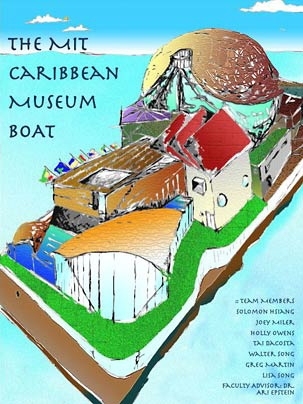Many Caribbean islands can only dream about having their own science and technology museum. So, MIT senior Solomon Hsiang is hoping they may eventually be able to share one.
Two years ago, Hsiang helped found the Caribbean Museum Boat Project team to develop a traveling museum to serve many communities.
The museum boat envisioned by the team would be an independent, nonprofit museum barge that could travel to different ports on different islands, allowing schoolchildren and families to explore science and technology exhibits hands on.
Still in the very early stages, the project was one of 28 entered in the annual IDEAS Competition, an annual event featuring ideas that could make a positive impact in the world. Participants work in teams to develop designs, plans, strategies, materials and mechanisms that benefit communities locally, nationally or internationally.
Although the Caribbean Museum Boat team did not win the competition, the idea was very well received and won for best poster in the competition's poster session, said Alison Hynd, IDEAS Competition and fellowships coordinator.
"They are a great team with a really ambitious project that I think they can pull off if they can gather enough support," Hynd said.
The idea was born in the summer of 2004 when Hsiang went with a small group of students from MIT and elsewhere to work for a think tank in the Dominican Republic. Margarita Cede̱o de Fernandez, who was about to become the country's first lady, said she wanted the Dominican Republic to have a science and technology museum, so the group took up the challenge.
But all of the existing museums visited by team members were being neglected, Hsiang said. "It was pretty obvious they would not be able to support the museum we wanted to build."
Instead, his team envisioned a shared museum that might make more sense in countries that did not have the resources to support a museum on their own. "We were working on our final draft by candlelight," Hsiang said, describing the lack of resources.
Once he returned from the island, Hsiang took his idea further and received support from the Terrascope program, which challenges freshmen to confront complex, real-world problems through interdisciplinary teamwork.
Hsiang had become part of the Terrascope community as a freshman and then worked as an undergraduate teaching fellow his sophomore year, said lecturer Ari Epstein of Terrascope and the Earth System Initiative.
When Hsiang approached Epstein, he immediately liked the idea and agreed to serve as team advisor. "For places that do not have the population or resources to keep a museum going, this seemed like a potential solution," Epstein said.
The barge would offer roughly 60,000 square feet of exhibit space. A few times a year, the boat would be towed to a new port. "The goal is to have some staff travel with the museum and some be local," Epstein said.
The museum would have "interactive exhibits," said sophomore team member Lisa Song. Topics covered would include astronomy, natural history, physics, chemistry and the environment. The museum would have a particular focus on issues relevant to island life, Song said. "We will have exhibits on hurricanes and ocean life in general," she said. Government officials in Jamaica and the Dominican Republic have expressed interest in the project, but there is also potential for growth into the U.S. Virgin Islands, Turks and Caicos and others.
For now, the boat would only dock at the largest cities, although travel to different ports on the same island has not been ruled out, Hsiang said.
For the team, the next step is to find further funding, both from local government and from businesses.
Several members of the team will spend their summer in the Caribbean, where they hope to make local contacts, develop support and better adapt the project to fit specific needs. Senior Josef Miler and junior Holly Owens are going to the Dominican Republic, while Hsiang will spend time both in the Dominican and in Jamaica. Sophomore member Tai Dacosta will be back in Jamaica, where he lives.
The other four team members will be at work in the United States, including Song, who will spend her summer touring science and technology museums around the country, gathering ideas to bring back to the group.
Physical Education, part of the MIT Department of Athletics, Physical Education and Recreation, sponsored the $75 prize for the poster competition and featured the Caribbean Museum Boat Project on its web site.
A version of this article appeared in MIT Tech Talk on May 24, 2006 (download PDF).






